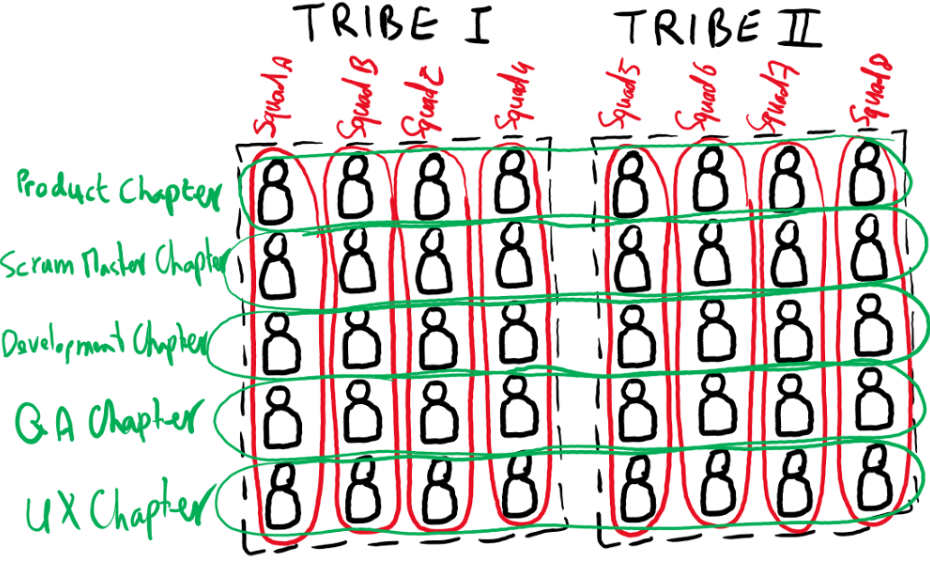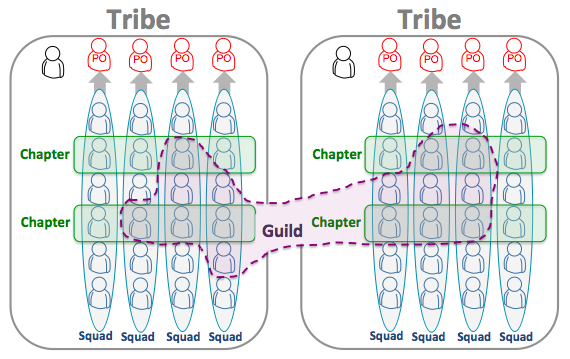Key Takeaways
Spotify launched in 2008, and has grown significantly, from 18 million to 124 million subscribers between 2015 and 2019, competing with major companies like Apple and Amazon.
• Spotify employs a unique organizational model known as the "Spotify model," which emphasizes agility, culture, and autonomous teams.
• Squads, Tribes, Chapters, and Guilds: The structure consists of "squads" (small teams focusing on specific missions), "tribes" (groups of squads), "chapters" (skill-based groups), and "guilds" (cross-discipline knowledge-sharing groups).
• The model allows squads to self-organize and choose their agile methodologies while maintaining accountability and ensuring knowledge sharing across teams.
• Spotify aims to balance autonomy with the need for collaboration to prevent redundancy and maintain efficiency.
• The company fosters a culture of continuous improvement and adaptability in its organizational structure.
• Some critiques suggest that the Spotify model is more aspirational than fully implemented, highlighting challenges as the company scales.
If, as the French novelist Gustave Flaubert once said, one can calculate the worth of a man by his enemies, perhaps one can do the same with a company and its close competitors.
By that measure alone music-streaming service Spotify is something special in the list of real org charts.
Consider that a business launched in October 2008 is now going head to head with Apple and Amazon (the world’s largest and fourth largest companies respectively) in its segment and winning. Between 2015 and 2019 its global subscriber number rocketed from 18 million to 124 million – an increase of 588 and put it way ahead of Apple Music and Amazon Music.
The company now has more than 4,400 employees and annual revenue of $6.8bn. And if Spotify has had a revolutionary effect on the music streaming industry, it has also made its mark on the world of organizational structure.
What is Spotify's org structure?
In 2012 Henrik Kniberg and Anders Ivarsson wrote Scaling Agile @ Spotify, a white paper that would become essential reading for anyone asking the question “what is Spotify’s organizational culture?”. The paper introduced what has since become known as the Spotify model -- a much talked-about, and in many cases emulated, way of structuring a company.
Kniberg and Ivarsson describe the model as a people-driven, autonomous framework for “scaling agile”.
So what does agility mean in an organizational structure context? McKinsey defined the trademarks of an agile organization as “including a network of teams within a people-centred culture that operates in rapid learning and fast decision cycles”. These in turn are enabled by technology.
Common characteristics of agile organizations are autonomous teams and a non-hierarchical system of operating procedures that can enable fast and flexible responses to shifts and changes in the market.
Working the Spotify Way
The Spotify model emphasizes the importance of culture and consists of “squads, tribes, chapters, and guilds”. Squads are the unit at the base of the Spotify model and are designed to consist of 6-12 people and feel like a small start-up business.
“Each squad has a long-term mission such as building and improving the Android client, creating the Spotify radio experience, scaling the backend systems, or providing payment solutions,” wrote Kniberg and Iversson.
Visitors to Spotify’s achingly cool headquarters in the heart of Stockholm’s Urban Escape innovation block may see squads gathered in areas for communal working like its conference rooms named after popular playlists, like RapCaviar, Deep Focus, Rock This or Guilty Pleasures.
Squads are usually allocated not only a desk area with whiteboards for walls but also, a lounge area, and a personal “huddle” room. To keep the creative juices flowing, they are encouraged to allocate 10% of their time to free-form “hack days” where they test out new ideas with their peers.

The priority for squads is that they be self-organizing and free to choose their own agile methodology -- whether this comes to Scrum sprints, Kanban (two different strategies for implementing an agile development or project management system) or a mix of the two.
Squads are mentored by an “agile coach”. White paper authors Kniberg and Iversson themselves, for example, occupied this position at the company.
A squad doesn’t have a formally appointed squad leader, but it does have a product owner, according to the authors. The product owner is responsible for prioritizing the work to be done by the team without specifying how it is to be done. And product owners of different squads collaborate to maintain a high-level roadmap document showing Spotify’s overall direction.
Multiple squads can group together to form a “tribe”. If squads are the start-ups in the Spotify model, tribes are the incubators that help bring their ideas to fruition. While tribes usually number more than 40 people, Kniberg and Iversson wrote that ideally they would number no more than 100.
The power of Spotify’s org design model
This aims to conform with the so-called “Dunbar number”, which says that most people cannot maintain a social relationship with more than 100 people. “When groups get too big, we start seeing more things like restrictive rules, bureaucracy, politics, extra layers of management, and other waste,” they wrote.
Each of the tribes has a lead, who is responsible for creating a productive and innovative environment for the squads. The squads in a tribe are physically in the same office, ideally close to each other.
As well as belonging to tribes, squad members also belong to “chapters” – groups of people with the same skillset and similar general competency area – for example “testing” or “web developer” chapters.
One of the most compelling sections of Kniberg and Iversson’s white paper is when they write of how one of the potential problems arising from full autonomy is a loss of economies of scale. If the autonomy really was complete, they ask, how would squad A know that squad B hadn’t already solved the problem they were currently working on?
“If all testers could get together, across squads and tribes, they could share knowledge and create tools for the benefit of all squads. If each squad was fully autonomous and had no communication with other squads, then what is the point of having a company?” they added.
Chapter and verse to be agile at scale
This is where chapters come in -- to ensure that standards are kept in place across individual disciplines and to maintain the benefits of economies of scale without losing flexibility and autonomy.
And it is achieving this balance between autonomy and accountability -- without sacrificing the latter, that is the power of the Spotify model, according to an article in Harvard Business Review.
“Every squad owns its features throughout the product’s life cycle, and the squads have full visibility into their features’ successes and failures,” said the article.
On a wider pan-organizational level people who share knowledge, tools, code, and practices are also part of a “guild”: for example a “web developers’ guild” or an “agile coaches’ guild”. Guilds usually conduct workshops rather than holding regular meetings.
 And in any given project, tribe leads, product leads and design leads might come together to form a trio and ensure there is continuous alignment between these three perspectives when working on features areas. This structure aims to recognise the risks that squads can become dependent on each other.
And in any given project, tribe leads, product leads and design leads might come together to form a trio and ensure there is continuous alignment between these three perspectives when working on features areas. This structure aims to recognise the risks that squads can become dependent on each other.
To insure against this, Spotify runs a quarterly survey to discover if dependencies are taking place and what kind of organizational support is needed. “Dependencies are not necessarily bad - squads sometimes need to work together to build something truly awesome,” wrote Kniberg and Iversson. “Nevertheless, our goal is to have squads be as autonomous as possible, especially minimizing dependencies that are blocking or slowing a squad down.”
Of course one of the big questions that has often been fired at the Spotify Model is whether even Spotify really adheres to it any more – or even if it ever did.
Is this a typical org structure of music streaming services?
Blogger Jeremiah Lee, who claimed he was a former Spotify employee, wrote a post titled: “Spotify doesn’t use “the Spotify model, and neither should you”. “I joined the company after it had tripled in size to 3,000 people over 18 months,” wrote Lee. “I learned the famed squad model was only ever aspirational and never fully implemented.” Lee went on to say that he had witnessed “organizational chaos” as Spotify transitioned to more traditional management structures.
But he held back from attacking Kniberg and Iversson. In fact, he said, they had always made it clear that the Spotify model was more aspirational than anything else. After all, Kniberg had said in accompanying interviews: “This culture description is really a mix of what we are today and what we want to become in the future.” And he quoted former Spotify agile coach Joakim Sundén as saying: “Even at the time we wrote it, we weren’t doing it. It was part ambition, part approximation. People have really struggled to copy something that didn’t really exist.”
As to the overall question, ‘how well Spotify has survived its own experiments with the “Spotify model”?’ – bear in mind that it ended 2020 with 155 million premium, or paid, subscribers, a 24 percent gain over the past year. At the same time its annual results for 2020 showed it had lost around $2.2 million a day throughout the year. But by the first quarter of 2021 it had started to turn a profit. Overall, the signs are encouraging but perhaps the jury is still out.
How to copy Spotify’s success
Whatever traditionalists may think of Spotify’s organizational structure, there’s no doubt they’re doing something very right with thousands of tech and SaaS companies looking to their structure for guidance in their own organizations.
One thing we can learn from Spotify is their obsession with continuous improvement. Org structure at Spotify is, and should be, ever changing and companies like Spotify are ever evolving, now more rapidly than ever before. Design tools such as powerpoint and whiteboards with sticky notes have had their day, but to keep up with constantly shifting teams, goals, and people, a certain intelligence is required.
Leverage what you have learned from real organizations like Spotify with purpose-built Org Chart creation tools. Easily and quickly create intelligent org charts, and bring the entire team together to plan your organization’s winning moves. Get started free, and start drafting your cross functional org today.
Use Functionly to visualize and design your organizational structure in minutes—no spreadsheets needed. Streamline your team dynamics and enhance collaboration, just like Spotify does with its innovative model. Start optimizing your org chart today!
Interested in startups? You might like this org template
Interactive template showing an example SaaS org at Series A, including structure, roles and responsibilities.
Photo Credits
Title header photo: "London Office 1" By Spotify via Spotify Media Kit




